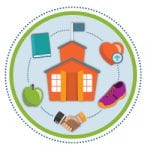Healthy schools foster academic performance
Schools that are responsive to the needs of the whole child are places where students are healthy, safe, engaged, supported, and challenged.
When a school community organizes to support the whole child through those five principles, exciting things happen: student attendance increases, behavioral issues decrease, parental involvement improves, teacher job satisfaction grows, and students thrive academically.
The Healthy Schools Toolkit is grounded in the Whole School, Whole Community, Whole Child (WSCC) model, a framework that highlights 10 specific components schools need to support the whole child so that he or she is healthy, safe, engaged, supported, and challenged. Think of the 10 components as the building blocks needed to construct a healthy school community.
These 10 components include:

- Health Education
- Physical Education & Activity
- Nutrition Environment & Services
- Health Services
- Counseling, Psychological, & Social Services
- Social & Emotional Climate
- Physical Environment
- Employee Wellness
- Family Engagement
- Community Involvement
The WSCC model was co-developed by leaders in education, public health, and school health, and it aims to increase integration and collaboration of these sectors. Since its release in 2014, the WSCC model has gained a lot of support from educators across the nation, and adoption of the model by schools and districts has been supported by a variety of tools and resources.
- Learn more about the WSCC model from ASCD and the Centers for Disease Control and Prevention (CDC), the organizations that led the development of the model.
- Review NACDD’s The WSCC Model: A Guide to Implementation to learn more about each component and the evidence that supports the connection between learning and health.
- Visit the CDC’s Virtual Healthy School to explore how the WSCC model shows up in schools and to download resources and information related to each component.
- Check out the list of additional resources for supporting healthy schools provided on our resources page.




Healthy schools are created with intention
Frameworks like WSCC don’t implement themselves. It takes intentional planning and coordination to execute such a model, because school communities are complex.
School districts that are spread out geographically must create opportunities for administrators, teachers, and staff from different buildings to build trust with one another and create a shared understanding of what it means to support health and well-being.
Even in a single school building, where teachers, support staff, administrators, and parents are in close contact, it is important to for the school community to come together to understand the unique and interconnected role that each person plays in creating a healthy school.
For example, the after-school tutor who sees a sad child at the end of the day needs to be able to talk to the cafeteria worker who saw the same child very hungry just prior to serving school breakfast, and also the teacher who noticed the child nodding off in the back of the classroom in the middle of the day. Making these connections requires a deep understanding of the people, systems, and messages that make up each school.
A focus on people, systems, and messages
This toolkit is designed to help school and district leaders organize their entire community to build a culture of health and well-being. It operates under the assumption that everyone, from teachers, administrators, and parents to nurses and counselors to cafeteria workers, bus drivers, and crossing guards, can play a part in building healthy schools—as long as they are organized, inspired, and effectively utilized.
Arranged into three modules, this step-by-step toolkit helps school and district leaders to understand:
- The people who are key influencers and can be recruited to inspire others to integrate health and well-being into their school communities;
- The existing systems in schools that help or hinder student health, well-being, and academic success;
- The aspirational messages about healthy schools that can spark interest and buy-in throughout the school community.
This toolkit is the result of a partnership between researchers and actual school leaders and stakeholders. Ultimately, it can help schools and school districts effectively strategize about coordination, programming, budgeting, policies, communication, and strategic planning.




Tools tailored to specific needs
The methods and activities used in this toolkit are based on social science tools that have been used by health care institutions, service industries, nonprofits, and other organizations to accelerate system changes in their organizations.
The tools include:
- Social Network Analysis, which uncovers the people, relationships, and structures that allow information and communication to flow among a group.
- Group Model Building, which brings people together to explore a problem, share ideas about how to solve that problem, and build motivation for change.
- Message Testing, which illuminates the words and phrases that resonate with people and make them want to take action.
Given that every school community is unique, this toolkit also helps users evaluate their own resources or “bandwidth” for completing the activities presented in the pages that follow. Users can choose the range and intensity of the activities they would like to complete and the order in which they would like to complete them.
